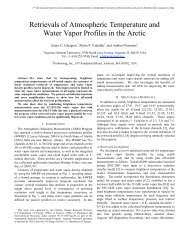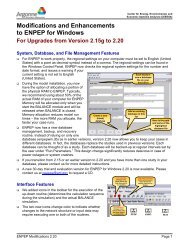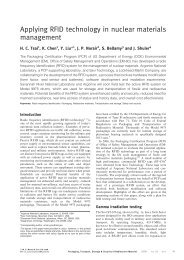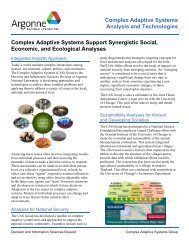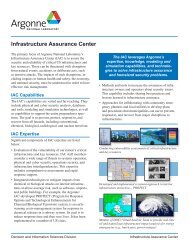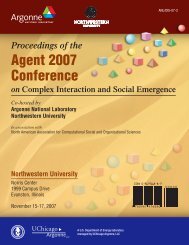Real-Time Tracking of Nuclear and Radioactive Material Packages ...
Real-Time Tracking of Nuclear and Radioactive Material Packages ...
Real-Time Tracking of Nuclear and Radioactive Material Packages ...
- No tags were found...
You also want an ePaper? Increase the reach of your titles
YUMPU automatically turns print PDFs into web optimized ePapers that Google loves.
during transportation. The system is an integration <strong>of</strong> multiple cutting-edge technologies, involvingradio frequency identification (RFID), global positioning system (GPS), two-way satellitecommunication, geographic information system (GIS), secured database <strong>and</strong> web servers, <strong>and</strong> a pilotRFID comm<strong>and</strong> center at Argonne National Laboratory. ARG-US Transport is capable <strong>of</strong> trackingvehicle location <strong>and</strong> monitoring “the state <strong>of</strong> health,” i.e., seal integrity, shock, temperature, humidity,<strong>and</strong> radiation (in the near future), <strong>of</strong> nuclear <strong>and</strong> radioactive materials packages in transport. When anysensor in the RFID tags exceeds its preset thresholds, an automatic alert/alarm is triggered <strong>and</strong> theevent will be reported immediately via satellites to the comm<strong>and</strong> center so that appropriate actions canbe taken to manage the situation. ARG-US TransPort can also issue GIS report using data in the preexistinggeodatabases that contain important information for the first responders in emergencymanagement.Since 2008 ARG-US TransPort has been tested on multiple package transportation platforms toevaluate system performance <strong>and</strong> reliability <strong>of</strong> the various components. Whereas the earlier tests <strong>and</strong>demonstration evaluated multiple prototypes <strong>and</strong> subsystems, 2 the latter tests <strong>and</strong> demonstrationfocused on contract-manufactured MK-II RFID tags <strong>and</strong> satellite communication gear widely used byindustry. 3 This paper will highlight results obtained in recent testing <strong>of</strong> ARG-US TransPort on (1) the“Big Bird” truck used by the Los Alamos National Laboratory (LANL) for the Off-site SourceRecovery Project (OSRP), 4 <strong>and</strong> (2) the Sprinter van used by the National Transportation ResearchCenter (NTRC), Oak Ridge National Laboratory (ORNL) for the Transportation Security TechnologiesTestbed. Both projects are sponsored by the USDOE National <strong>Nuclear</strong> Security Administration(NNSA). Special attention was paid during testing on establishing the inherent latency <strong>of</strong> satellitecommunication that would ultimately define “real time,” or more precisely, the “nearness” to the realtimecapability <strong>of</strong> the present ARG-US TransPort system.ARG-US TransPortARG-US TransPort is designed with the key requirement that the system must be able to continuouslymonitor the status <strong>of</strong> packages in a moving vehicle, <strong>and</strong> report any abnormal event to the comm<strong>and</strong>center in “real-time.” Other design requirements include allowing access to data <strong>and</strong> event history byauthorized users over a secured webpage on the Internet, <strong>and</strong> automation <strong>of</strong> the system in the vehicleso that the driver is not distracted from driving.Figure 1 is a schematic diagram showing the communication design <strong>of</strong> ARG-US TransPort. Thecommunication paths, shown in two-way arrows, start from an RFID tag all the way to a remote enduser or system administrator, <strong>and</strong> vice versa. One complete path may involve a tag-initiated alert/alarmwhen its battery-powered sensors detect a threshold violation; another complete path, in reversedirection, involves instructions issued by the comm<strong>and</strong> center to reset the tag after the cause has beendetermined for clearing the alarm. The communication between the RFID tag <strong>and</strong> interrogator isachieved via 433 MHz radio waves over the air, <strong>and</strong> the events are recorded both in the non-volatilememory <strong>of</strong> the tag <strong>and</strong> the database server for future references.Since the interrogator, also known as reader, <strong>and</strong> the MK-II RFID tag have a known omnicommunicationrange <strong>of</strong> ≈100 m, a reader installed inside a vehicle has no difficulty in receiving taginitiatedalert/alarm instantly. Under normal operating conditions, however, the reader is alsoinstructed by the control computer to query (or poll) the tags at regular intervals, e.g., minutes, orcontinuously to ensure that tags are present <strong>and</strong> functioning. Absence detection <strong>of</strong> tags, which are2


